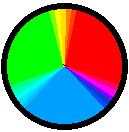

Courageous risks are life giving, they help you grow, make you brave and better than you think you are. Joan L. Curcio
In Spring 2001 I moved my course to a course software called Blackboard or CourseInfo. I'll leave this information here so students can view a self-designed Internet course and so prospective students can get a feel for the nature of the course. Follow instructions in the Blackboard/CourseInfo site. Not these.
This page has an orientation (with an introduction for beginners) to the main sections of the course. It begins with a link to a visual map and some tips for web students. You may freely borrow/copy the tips section. I hope we add to it over the course of the semester. The map and hints links are repeated at the bottom of the page.
The following graphic is large and is probably best read printed out. Change your print setup to landscape orientation. (Don't forget to change it back.) Be aware that a web site is fluid and particular links may vary. This is a general guide to the course site.
To access a flowchart map click here. (http://edtech.wku.edu/~internet/maps.htm)
This is the link to a page of hints for the Internet student. (http://edtech.wku.edu/~internet/hints.htm). You can also access this page from the class resources page (http://edtech.wku.edu/~internet/resour.htm)
If you have any questions, please be sure to email me at sally.kuhlenschmidt@wku.edu
If you have not surfed the 'net much then a web site can be confusing. Unlike a book you don't have to "read" a web site in any particular order, although it can help to be methodical.
The site developer has placed "links" on the page. You position your mouse on a link (typically underlined, colored text), the cursor changes shape, and you click once to jump to a new page.
You can use your browser's back and forward and history or "go" commands to move about independently of the web designer's links. You determine the order of your reading!
Web sites are generally constructed as a hierarchy of files (like an organizational chart or the branches of a tree). This course site is hierarchical. The arrows represent the links you would click on to move to another site. Each page is actually a computer file of code that your browser interprets.
Tutorials are often constructed
as a straight line sequence. (Page A links only to page B which only links to
page C, etc.). ![]()
Now, look at the web address for this site up in the address or location line of your browser.
If you look at the very last segment you will see the name of this page (orient.htm). This is the name of the computer file holding the information you are reading. When you select links you move between different files on a computer.
You probably initially visited a very short page (file name: index.htm; The file name doesn't appear in the address because it is a default file.) This page had a link to the FAQ (Frequently Asked Questions) file with registration information. It also had a link to student comments (cmt.htm) and to Web sites created by 501 students (studpgs.htm). Finally, there is a link (psyii.htm) to the page I originally built as the course home page. On it I provide links to every main course section on the self-constructed site.
Psyii.htm is the central organizing page. Each of the main links is explained below. Some links are restricted only to persons registered for the course. When a student is registered, I send a User ID and password.
[With the course software site (Blackboard/CourseInfo) the User ID and Password are taken care of by central administration. If you are a registered student you will find the following links within the Blackboard site.]
The first four relate to administrative issues/information
The next links relate most directly to course content.
To access a site map click here.
This
is the link to a draft page of hints for the Internet student.